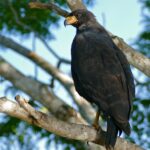The great black hawk (Buteogallus urubitinga) is a majestic bird of prey known for its impressive wingspan. With a length of 56 to 64 centimeters (22 to 25 inches) and a weight of 1.1 kilograms (2 lb 7 oz), this raptor is a formidable hunter in the tropical regions of the New World.
The Expansive Wingspan of the Great Black Hawk
The great black hawk’s wingspan is a key feature that sets it apart from other birds of prey. Its wings are incredibly broad, measuring an impressive 122 to 145 centimeters (48 to 57 inches) in width. This expansive wingspan allows the great black hawk to soar effortlessly above the forests and open woodlands it calls home, scanning the ground for its next meal.
Adaptations for Efficient Flight
The great black hawk’s broad wings are not just for show; they serve a crucial purpose in the bird’s hunting and foraging behavior. The wide wingspan provides the hawk with exceptional maneuverability, enabling it to make sharp turns and sudden dives to catch its prey. Additionally, the large surface area of the wings allows the bird to glide and soar with minimal effort, conserving energy during long flights.
Hunting Strategies Enabled by the Wingspan
The great black hawk’s impressive wingspan gives it a distinct advantage when hunting. Its ability to soar and glide above the canopy allows it to spot potential prey from a distance, whether it’s reptiles, small mammals, birds, or even fish. The hawk can then swoop down with incredible speed and precision, using its sharp talons to capture its target.
Habitat and Behavior of the Great Black Hawk
 Image source: Great Black Hawk by Bernard DUPONT
Image source: Great Black Hawk by Bernard DUPONT
The great black hawk is a resident of the tropical regions of the New World, found from Mexico through Central America to Peru, Tobago, and northern Argentina. It prefers coastal areas, forests, and open woodlands near water sources, where it can find an abundance of its preferred prey.
Nesting and Breeding Habits
The great black hawk builds a large stick nest in the branches of a tree, often near a water source. The female typically lays a single dark-blotched whitish egg, which both parents take turns incubating. Once the chick hatches, the parents work together to provide food and care for the young hawk until it is able to fend for itself.
Vocalizations and Behavior
The great black hawk has a distinctive piping call, often described as ooo-wheeeeee. This call can be heard as the bird soars above the treetops or perches on a high branch, surveying its territory. The hawk is known to be a solitary and territorial bird, defending its hunting grounds from other predators.
Conservation Status and Threats
The great black hawk is currently classified as a Least Concern species by the International Union for Conservation of Nature (IUCN). However, like many birds of prey, it faces threats from habitat loss, hunting, and the use of pesticides.
Habitat Destruction and Fragmentation
As human development encroaches on the tropical forests and coastal areas where the great black hawk lives, its natural habitat is being destroyed and fragmented. This can lead to a decline in the hawk’s prey populations and make it more difficult for the bird to find suitable nesting sites.
Hunting and Persecution
In some regions, the great black hawk is hunted for its meat or feathers, or persecuted as a perceived threat to livestock or other wildlife. This direct human-caused mortality can have a significant impact on local populations of the species.
Pesticide Contamination
The use of pesticides and other chemicals in agriculture can also pose a threat to the great black hawk. These toxins can accumulate in the food chain, potentially poisoning the hawk and affecting its reproductive success.
Conclusion
The great black hawk is a remarkable bird of prey, known for its impressive wingspan and hunting prowess. Its broad wings not only allow it to soar effortlessly above the tropical forests and coasts it calls home, but also give it a distinct advantage in catching its prey. While the great black hawk is currently classified as Least Concern, it faces ongoing threats from habitat loss, hunting, and pesticide contamination. Conserving the species and its natural habitats is crucial to ensuring the continued survival of this magnificent raptor.
References:
– Great Black Hawk – Wikipedia
– Great Black Hawk – Oiseaux-Birds.com
– Great Black Hawks – EarthLife.net
– Great Black Hawk – Britannica
– Common Black Hawk – All About Birds


